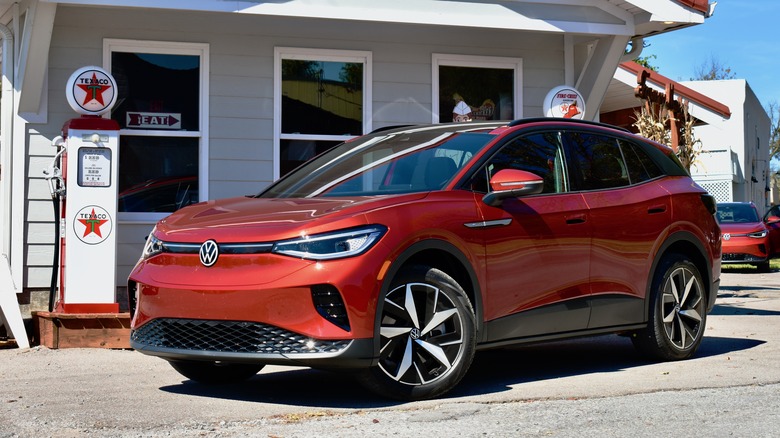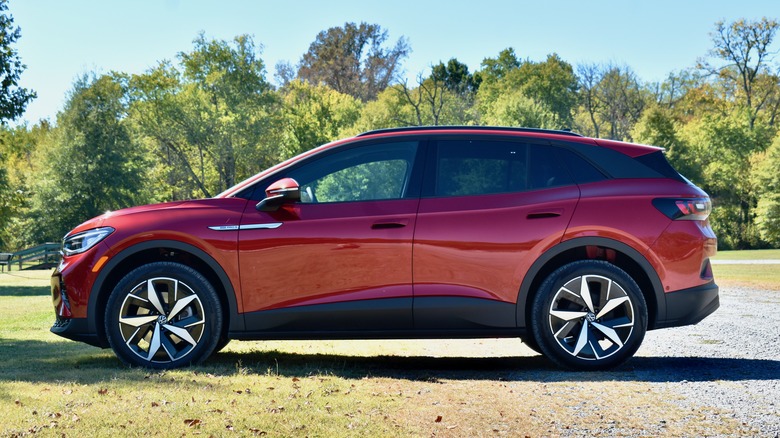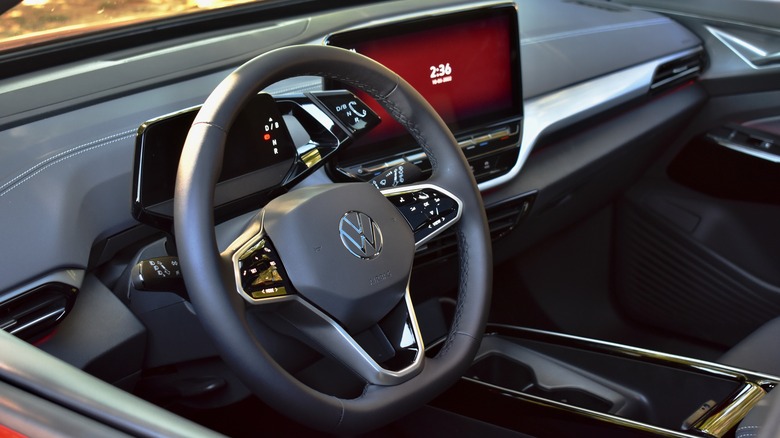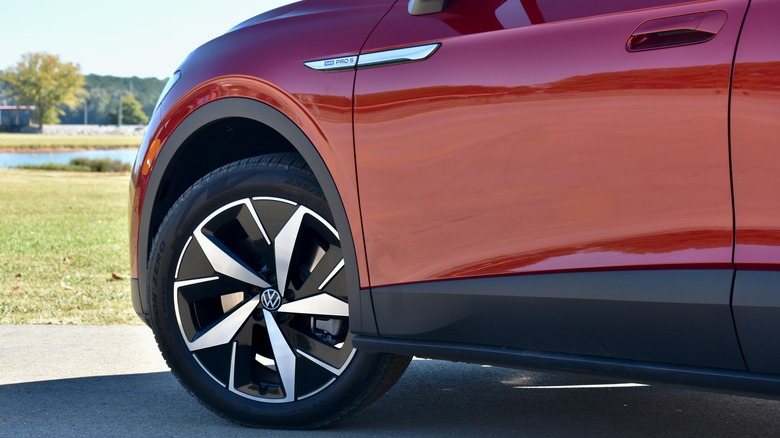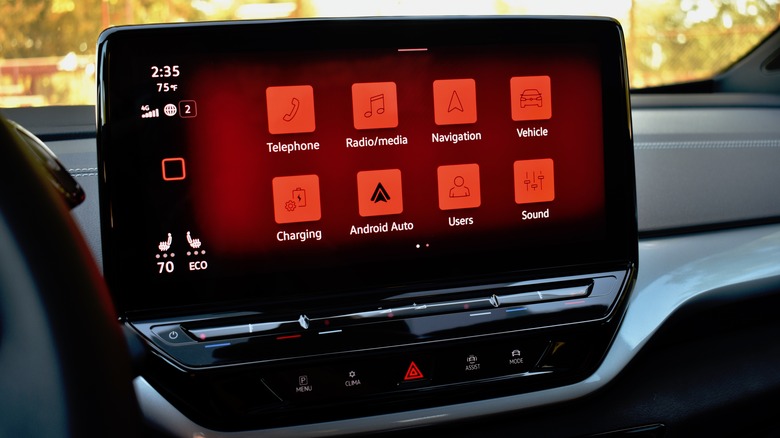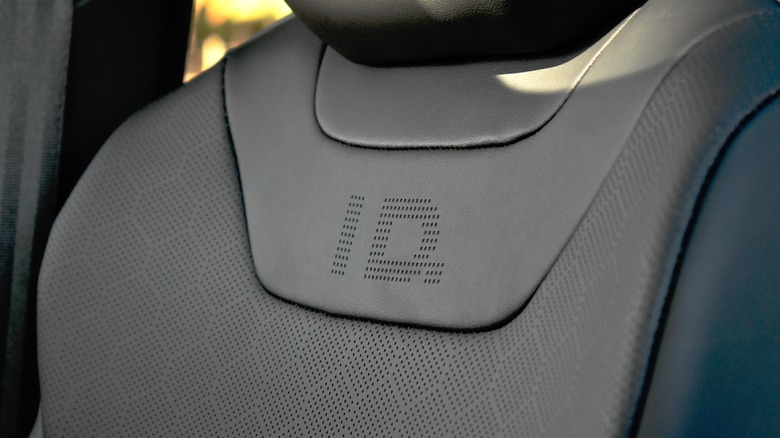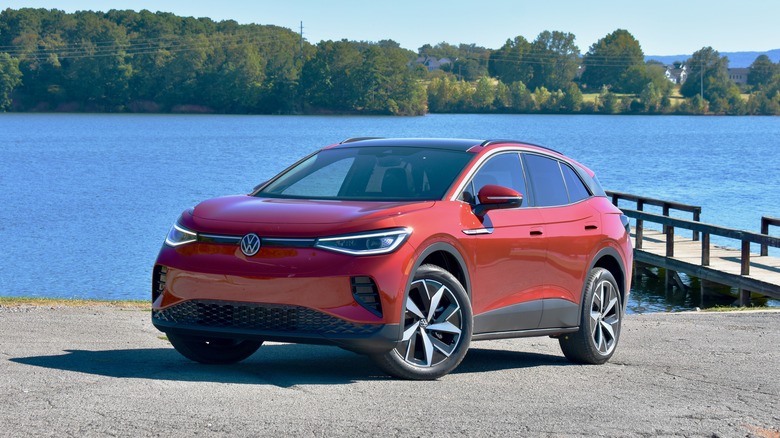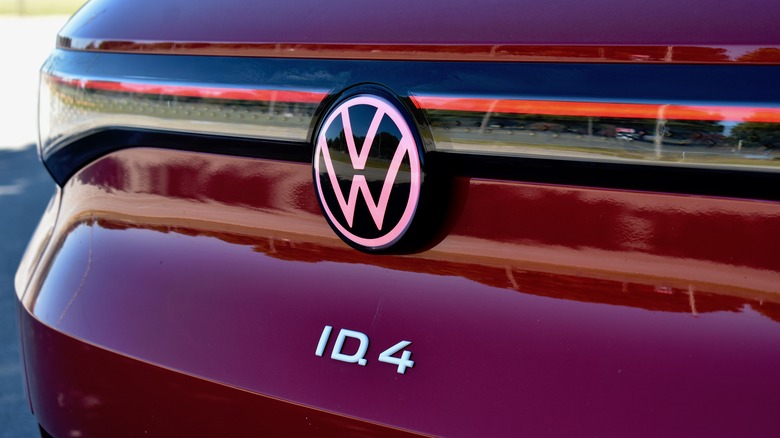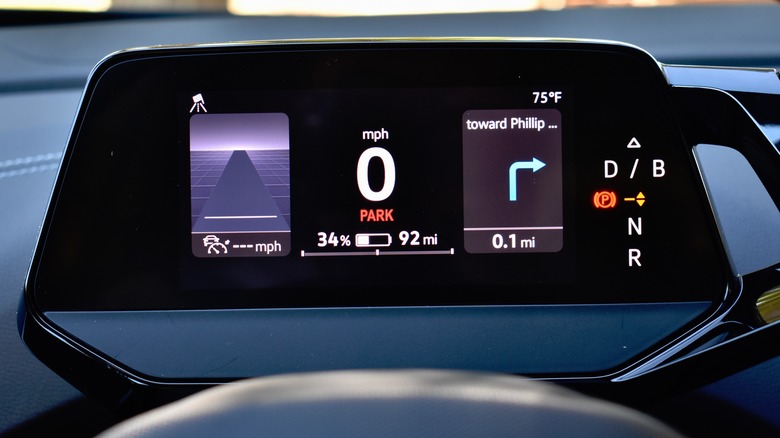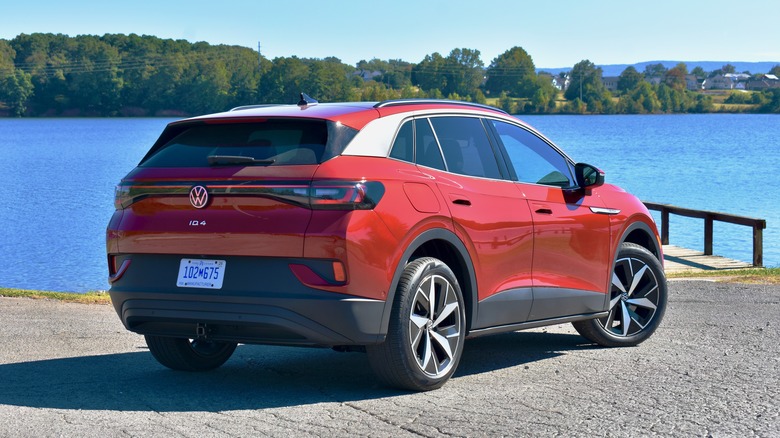2023 Volkswagen ID.4 First Drive: Heading In The Right Direction
Faced with a massive diesel emissions scandal, Volkswagen went all-in on electric cars, pursuing one of the most aggressive electrification strategies of any major automaker and aiming to put tens of millions of EVs on the road globally by the end of the decade. For VW's North American arm, the ID.4 is the key to that strategy.
Ahead of its launch two years ago, then-Volkswagen Group of America CEO Scott Keogh said the ID.4 was the company's most important model since the Beetle. That's because the ID.4 is the first of the mass-market-aspiring EVs based on VW's infinitely flexible MEB platform to reach this audience. For the 2023 model year, the ID.4 takes a big step toward that broad appeal goal.
In its third model year, the ID.4 adds an entry-level version with a 62-kilowatt-hour battery pack priced below the existing 82-kWh models. Perhaps more significantly, VW says it will begin stocking dealerships with cars built at its Chattanooga, Tennessee, factory—something it's been talking about since the ID.4's launch. Until now, all cars for North America have been sourced from Zwickau, Germany.
Battery downsizing
The new-for-203 62-kWh pack is installed in an also-new base model called the ID.4 Standard, as well as the carryover ID.4 S trim level. It has nine modules instead of the 82-kWh pack's 12, and all U.S.-assembled cars have slightly different battery chemistry because cells are sourced from South Korean firm SK Innovation's Georgia plant, as opposed to the LG cells that go into cars produced in Germany.
VW generally discusses its packs in terms of gross capacity, so it's worth noting that the 62-kWh pack actually has 58 kWh of usable capacity, compared to 77 kWh of usable capacity for the larger pack. That works out to a VW-estimated 209 miles of range, which is respectable. For context, the Nissan Leaf Plus gets 212 miles from a 60-kWh pack, while the Chevrolet Bolt EV is rated at 253 miles with a 65-kWh pack.
Naturally, less battery capacity means less range, though. With the standard single-motor rear-wheel drive powertrain, VW expects 82-kWh models to achieve 275 miles of range. Going for the dual-motor all-wheel drive powertrain (which is only available with the larger pack) knocks that down to 255 miles.
Enhanced driving dynamics
We averaged an indicated 3.3 miles per kWh during a roughly 200-mile between Nashville and the ID.4's Chattanooga birthplace. The smaller battery pack does not affect output, however. The 62-kWh models get the same electric motor as rear-wheel drive 82-kWh models, with an identical 201 horsepower and 229 pound-feet of torque. That's unchanged from previous model years. However, the 62-kWh pack reduces curb weight by 240 pounds, which should improve acceleration, VW claims.
We only had a brief drive in a 62-kWh prototype on the streets of Chattanooga and, while it felt quite peppy, we'd need a back-to-back comparison with the larger-battery version to confirm any real difference in accelerative feel. We'd also like to take a 62-kWh car on a twisty road, as the weight reduction likely benefits handling as well. Of course, if performance is what you're after, Volkswagen has just the thing (assuming you're willing to spend a little extra).
Traction and performance
We spent most of our drive day in all-wheel drive ID.4 Pro S model, which is definitely the hot rod of the lineup thanks to a combined output of 295 hp and 339 lb-ft of torque from its two motors. With a factory-estimated zero to 60 mph time of 5.7 seconds, the all-wheel drive ID.4 is legitimately quick. VW needed to include all-wheel drive for the ID.4 to live up to its SUV billing, but the giggle-inducing acceleration is a much-appreciated bonus.
The only sporty thing about the ID.4 driving experience is the power, however. While essentially the same powertrain is packaged as an ID.4 GTX performance model in Europe, VW didn't make any changes from the rear-wheel drive models that would improve handling or braking. All versions lean more toward comfort than performance. Th ID.4 has excellent ride quality and an overall feeling of refinement, but merely muddles through corners.
Still, an all-wheel drive ID.4 with better tires and sportier suspension is an intriguing concept. ID.4 R, anyone?
Infotainment still needs improvement
The ID.4 also gets some tech updates for the 2023 model year. The formerly optional 12.0-inch touchscreen is now standard, and VW made some tweaks to the infotainment system software to make it more responsive. Still, the interface remains a bit of chore.
That's because VW kept the haptic touchpads for important functions like climate control and audio volume and, while they provide the smartphone-like aesthetic all automakers seem obligated to imbue their EVs with, they are quite annoying to use. Turning down the volume, for example, requires prodding an unyielding piece of plastic that will have you wondering whether you're touching an actual control point or just a random bit of the dashboard. And like your smartphone, merely being exposed to the atmosphere generates a layer of fingerprints and dust on these surfaces.
It's not all bad, though. The button-free design does at least fit the ID.4 better than the similar setup in the Golf GTI and Golf R hot hatchbacks, where it seems out of sync with those cars' characters. You can also rely on the ID.4's competent natural-language voice recognition system and the touchscreen for most functions. It features nice graphics, as does the accompanying digital instrument cluster.
As before, the ID.4 gets a decent array of standard driver aids, including Travel Assist 2.0, which essentially combines adaptive cruise control with automated lane centering for highway driving, and Emergency Assist 3.0, which can pull the car over if the driver appears incapacitated, plus expected features like forward collision warning, automatic emergency braking, and blind spot monitoring. A Park Assist Plus automated parking system and 360-degree camera system are new for 2023.
Aspirational interior
The interior itself is also a nice place to be, with a feeling of quality that translates even to the base ID.4 Standard model. Aside from manual front seats, there were no obvious differences between this base model and the higher-level Pro S we drove.
For 2023, VW also added some stitching to the door panels and dashboard. It's the traditional way automakers communicate that they spent a little extra money on an interior. But the ID.4 already had fairly nice-looking interior materials for its price point, so that wasn't really needed.
VW also reworked the center console, replacing the unusual sliding cover with a more conventional lid, and adding a more convenient spot for a phone, complete with a clip. What hasn't changed is the ratchet-like shifter, which is actually attached to the right side of the instrument cluster. It may seem strange at first, but it certainly reduces dashboard clutter.
An EV comfortable in its own skin
Among the changes to the ID.4 for the 2023 model year, the exterior styling tweaks are among the most subtle. VW spokespeople pointed out the added gloss-black trim on the front fascia, and small changes to the rear bumper aimed at improving aerodynamics, but we doubt anyone will notice them. But people will definitely notice the rear VW logo, which now lights up like the front logo, only in red (because it's part of the brake lighting).
The mostly carryover styling makes the ID.4 easily recognizable as both an EV and a Volkswagen. The rounded shape and lack of a grille counter internal-combustion styling orthodoxy without just being weird for weirdness' sake. And unlike traditional SUVs, the ID.4 doesn't try to look aggressive or rugged. It's got a friendly, approachable vibe—not unlike the original Beetle. Granted, the ID.4 looks positively enormous parked next to an original Beetle, or even an original Golf or Jetta. Yet it's still compact by modern standards.
At the same time, the styling elements VW has decided to make the signifiers of its MEB-based EVs are apparent. The ID.4 is clearly a sibling to the European-market ID.3 hatchback, and you can see a more distant resemblance to the whimsical ID.Buzz electric van that's coming to the U.S. in 2024.
Faster and easier charging
We didn't have an opportunity to charge (although the car was pleading with us to do so toward the end of our roughly 200-mile drive), but VW made some improvements here as well.
Models with the 82-kWh battery pack can now DC fast charge at up to 170 kilowatts (up from 135 kW), allowing for a 10% to 80% charge in 30 minutes, according to VW. Models with the 62-kWh battery pack have a less-powerful charge rate of 140 kW, but the smaller pack size should work out to a relatively short charge time.
The ID.4 also gets Plug and Charge connectivity for 2023. This means drivers can now start a charging session at a public station simply by plugging in: the car automatically starts charging, and the cost is billed to a pre-arranged payment method. The ID.4 also comes with three years of free 30-minute charging sessions at Electrify America stations, which were financed by VW as part of the automaker's diesel-emissions cheating settlement.
The ID.4 also has an onboard 11 kW charger that can fully charge the 62-kWh pack in six hours and 15 minutes, and the 82-kWh pack in seven hours and 30 minutes.
Cheaper, but not the cheapest
In new-for-2023 Standard form with the 62-kWh pack, the ID.4 has a base price of $38,790 with destination. That's $3,165 less than the cheapest 2022 ID.4, and could be effectively reduced by the $7,500 federal EV tax credit, if the ID.4 qualifies under new rules enacted as part of the Inflation Reduction Act (VW spokespeople said the company is still waiting on guidance from the Treasury Department to confirm eligibility).
For now, the ID.4 is neither the cheapest mass-market EV nor the most expensive. It can't match the price of Chevy's Bolt EV, which got a $5,900 price cut for 2023 and now starts at $26,595 with destination. But the base ID.4 undercuts the Hyundai Ioniq 5, Nissan Ariya, and Toyota bZ4X/Subaru Solterra twins.
Move up the trim-level ladder, though, and you'll soon find yourself spending comparable money to those EVs. The all-wheel drive ID.4 Pro S we drove had a $52,985 as-tested price. So while the base ID.4 is relatively affordable, the same can't be said for the whole lineup. And VW is still a few grand off from the $35,000 target it discussed when the ID.4 was unveiled.
2023 Volkswagen ID.4 verdict
VW has ramped up EV production capacity more quickly than many other automakers, however. At Chattanooga, ID.4s are now rolling off the same assembly lines as the gasoline-powered VW Atlas and Atlas Cross Sport and waiting patiently in the facility's giant parking lots for shipment. Considering the troubles the auto industry is experiencing in general, as it tries to scale up to meet post-pandemic demand, that's impressive.
In fact, an electric car built at a modern robot-filled factory on what was once the site of an Army ammunition plant in the American South sounds like an industrial fairytale, but it's reality now. While the U.S. automakers have made similar pledges to build more EVs domestically, only VW is actually doing it today. That's what really makes the ID.4 important. The Beetle helped mobilize the masses, but the ID.4 (and its MEB platform-mates) could be a big contributor to a future of zero-emission transportation.
